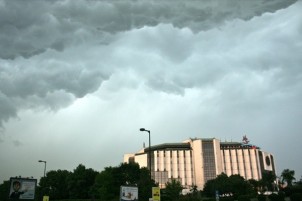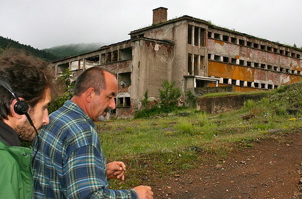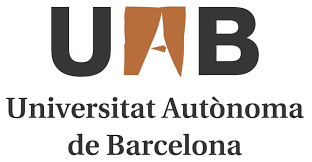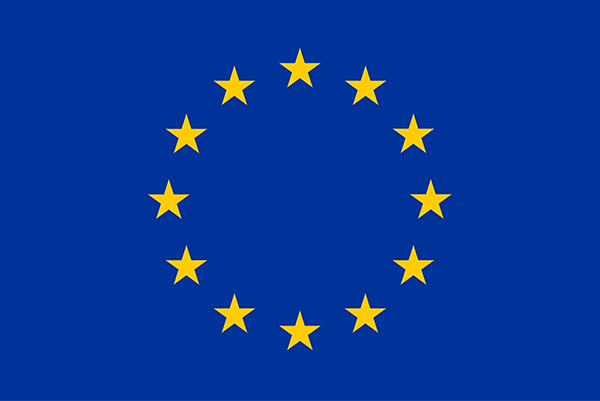
From 6 to 11 June, EJOLT partner Za Zemiata guided the ‘EJOLT-nuclear-team’ through the dirt left behind by the nuclear industry in Bulgaria. Literally. We visited an old uranium mine site where we did measurements and continued the toxic tour around a former yellow-cake factory, where uranium is extracted from the rocks.
Our impressions of the legacy this industry has left behind might explain why most of us did not touch the fluorescent pink cake offered as a desert, let alone eat them. Later, there were several public meetings in Buhovo and in Sofia and Za Zemiata also allowed us to hold a well attended press conference. In short, the nuclear toxic tour in Bulgaria was a sometimes shocking but altogether ‘enriching’ trip where we used the opportunities for knowledge exchange between activists and scientists across national borders. A big thanks to Za Zemiata!
I had my own little side-mission within the toxic tour: to come home with sufficient quote’s, anecdotes and context for a longer press article. All in the hope to spread awareness on uranium extraction practices in Belgium, my tiny country that still depends from nuclear power for almost 60% of its electricity and still doesn’t know if or when it will close the old nuclear facilities it has. We don’t have uranium mines ourselves and we do no longer colonize, terrorize and plunder the Congo to get it the cheap way, as we did before 19601, but it still has to come from somewhere. Although Bulgaria no longer has active uranium mines since 1992, some of its mines used to play an important role in history. In 1938, uranium from the Buhovo mine, which we visited, was sold to the army of Hitler for ‘unknown’ reasons. Some years later it was exported from here to produce the first Soviet atom bomb, according to Todor Dimitrov, a former major of the town. While this ‘fame’ did not bring many benefits part from some temporary and dirty jobs, we could see for ourselves how the legacy of those years continues to inflict damage to the citizens of this little town, even today.
While Todor Dimitrov is scanning stones with his old Russian Geiger counter in the hope of showing us some very radioactive ones, I turn my eyes to a strange building. A skeleton would be a better word to describe a structure from which every single item deemed slightly useful has already been taken off, including bricks and any type metal items it probably once had. There’s a thriving informal economy in waste pickers and recyclers here, where it’s mainly the Roma who do the dirty work. A bit further we meet one who’s digging a hole in a waste dump from the factory that used to turn uranium into yellow cake. “These people have no idea how dangerous this is and even when we tell them, they will still do it due to a lack of other income generation options”, explains Todor Slavov from Za Zemiata. At the newly constructed pic-nic place, on the spot where waste rock from the mine was dumped, Todor Dimitrov’s machine goes crazy. We find some rocks of a size that fit in a child’s hand with a radioactivity 1000 times the natural value. This is where some people from Sofia come for mountain biking and camping. Somewhere, something has gone terribly wrong.
I then learned from Bruno Chareyron, a nuclear physician from CRIIRAD, which is one of the other 23 partners in EJOLT, that even in France a lot of problems with the 200 closed uranium mines still exist. They might even get worse in the future, as human memory will probably not survive the few billion years in which the waste rocks keeps emitting a list of 13 types of radioactive particles and thus doing damage. Bertchen Kohrs, an environmental activist from Earthlife Namibia, added her experiences with the uranium rush in Africa, as this is now considered the “place to be” for multinationals searching for countries with a lack of legislation. This is the Lawrence Summer Principle in action and for those of you who want to learn what that principle is all about: click here and go to the glossary.
Meanwhile, down at the town hall in Buhovo, Todor Dimitrov brings our ‘EJOLT-nuclear-team’ together with a dozen of concerned citizens and activist. He presents a letter that he wants to send to the authorities and asks for feedback and advice. After integrating the comments from us and the locals, he prints the letter again and asks us to sign. Only one idea didn’t make it. Someone from EJOLT offered to add a radioactive rock from the pic-nic spot to the letter. But according to the ex-mayor, “that would be considered as an act of terrorism by the authorities”. Never mind that the people from Buhovo are living on and with such rocks since more than seven decades. All people we spoke to were either skeptical or apathetic towards the national authorities, who they don’t trust.
Which raises the question: what role is there for the EU? Professor Joan Martinez Alier from the University of Barcelona and coordinator of the EJOLT project, informed locals about a recently passed European Directive on Environmental Liabilities which they might use to claim compensations. We learned that the EU has already payed a few million euros to strengthen the dam of a tailings pond, a pond that contains radioactive water. But from our visit it was clear that there’s lots more to do to prevent nuclear contamination from spreading, let alone to rehabilitate the damage already done to this forgotten town at the outskirts of Sofia. As Bruno expressed it well at the end of his speech in Buhovo: we probably need an international coalition of activists, scientists, local policy makers, media and concerned citizens to put governments under sufficient pressure before they address environmental injustices like this. He injected some hope by referring to cases in France where Areva was forced into clean-up operations. At the same time, examples like Buhovo should remind countries who use uranium for their nuclear power about the liabilities they have elsewhere. This is what environmental justice is all about. In the globalized world we live in, we are accountable for the global consequences of a decision by national policymakers in one country to keep relying on nuclear energy, wether that is Bulgaria or Belgium. Buhovo shows us a glimpse of the hidden damages that, if nobody addresses them, will last forever. Well, at least for the next couple of billion years.
1During World War II Belgium provided uranium from Congo to the US and they returned the favor by giving Belgium a totally disproportional big amount of votes at the IMF, which we lost only this year during the latest IMF reforms.






Pingback: Uranium liabilities | Kennelmanagement